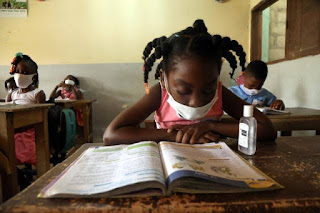COVID-19:WHO releases recommendations for reopening schools
The United Nations Health Authority, the World Health Organization, has recommended developing, where possible, the following strategies and adjustments to minimize corona virus spread (COVID-19):
Teach everyone in the school about COVID-19 prevention, which includes appropriate and regular hand hygiene, respiratory hygiene, mask use if needed, symptoms of COVID-19 and what to do if you feel ill. Greetings should also be advised not to make contact. Provide weekly updates on these cases as the epidemic unfolds.
Set up a schedule for regular hand hygiene, specifically for young children, and provide adequate scrubbing with soap and adequate clean water at the entrances and throughout the school. Make regular appointments for regular cleaning of the school environment, including toilets, with soap and water,such as door handles, offices, toys, lighting switches, door boxes, toys, children's toys and book covers.
Evaluate what can be done to reduce the risk of exposure or direct physical contact in physical education, sports or other physical activities, and in stadiums, wet areas and changing rooms.
Increasing the frequency of cleaning in the gym, sports facilities and changing rooms, the provision of hand hygiene stations at the entrances and exits, the establishment of a sports session for athletes by the facilities and the reduction in the number of people simultaneously in the changing room allowed.
Develop breathing, hand hygiene and long-distance measures in transportation, such as school buses, and advice for students on safe transportation to and from school, including those using public transport. Only one child per seat and separate at least one meter on school buses if possible. This can increase the number of buses for each school. Bus windows should be left open if possible.
Draw up a school policy on wearing a face mask or face mask in accordance with national or local guidelines.
If a child or a school staff is seek ,he/she should not come to school.
Apply a policy of "at home if you are good" to students, teachers or school staff experiencing symptoms. Contact the local organizations, if possible, to provide home care and to ensure communication between the home and the school.
The WHO recommends 70% ethyl alcohol for disinfection of small spaces and equipment, or 0.1% sodium hypochlorite for surface disinfection
Create a checklist for parents / students / employees to determine whether students / staff can attend school, taking into account the local epidemiology of COVID-19. The checklist may include: basic medical conditions and vulnerabilities, for the protection of students / employees; A recent illness or symptoms suggesting COVID-19 is spread to others; Special circumstances in the home environment to provide support as needed; Special considerations regarding school transport if necessary
Removal of the physician observation requirement to justify the absence when there is a community transfer of COVID-19
.
Consider the daily examination of body temperature, history of fever or fever during the past 24 hours as you enter the building for all staff, students and visitors to identify sick people.
Make sure students who have been in contact with the COVID-19 case stay at home for 14 days.
School officials should notify public health authorities of a COVID-19 positive case.
Set up procedures for students or employees who experience symptoms of COVID-19 or in any way feel bad about being brought home or isolated from others.
Communication with parents and students
Inform the parents about the measures the school is taking and request co-operation to report the cases of COVID-19 that occur in the family. If a family member suspects COVID-19, keep the child at home and notify the school.
Explain to students the reason for school-related measures, including the discussion of scientific considerations and the help they can get through schools (such as psychosocial support).
, the of a sports for facilities











Comments
Post a Comment